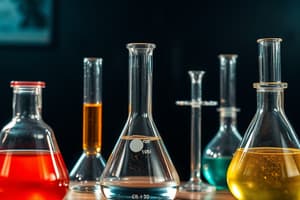Podcast
Questions and Answers
Which of the following best describes the difference between independent and dependent variables in an experiment?
Which of the following best describes the difference between independent and dependent variables in an experiment?
- The independent variable is what is changed, and the dependent variable is what is measured. (correct)
- Both variables are dependent on each other.
- The independent variable is what is measured, and the dependent variable is what is changed.
- Independent variables are constants, while dependent variables can vary.
Which of the following best describes a characteristic of ionic bonds?
Which of the following best describes a characteristic of ionic bonds?
- They typically occur between metals and nonmetals. (correct)
- They are characterized by weak attractions between molecules.
- They involve the sharing of electrons between atoms.
- They form between atoms with similar electronegativities.
What happens to light waves when they strike a surface and are absorbed?
What happens to light waves when they strike a surface and are absorbed?
- They increase in wavelength and scatter.
- They are reflected back into the environment.
- They pass through the material and are transmitted.
- They convert into heat energy. (correct)
What is necessary to satisfy the law of conservation of mass in a chemical reaction?
What is necessary to satisfy the law of conservation of mass in a chemical reaction?
Which of the following best describes the greenhouse effect?
Which of the following best describes the greenhouse effect?
What is the primary distinction between reactants and products in a chemical reaction?
What is the primary distinction between reactants and products in a chemical reaction?
Which statement accurately represents the relationship between ionic and covalent bonds?
Which statement accurately represents the relationship between ionic and covalent bonds?
How do positive feedback loops differ from negative feedback loops in ecological systems?
How do positive feedback loops differ from negative feedback loops in ecological systems?
In the context of light behavior, what occurs during the process of refraction?
In the context of light behavior, what occurs during the process of refraction?
What is the effect of the greenhouse gases on the Earth's atmosphere?
What is the effect of the greenhouse gases on the Earth's atmosphere?
Flashcards
Chemical change
Chemical change
A change in which the substance's chemical makeup is altered. New substances are formed and the original substance is gone.
Physical change
Physical change
A change in a substance's physical state or appearance without altering its chemical makeup. No new substances are formed.
Reactants
Reactants
The substances that are present at the start of a chemical reaction.
Products
Products
Signup and view all the flashcards
Conservation of Mass
Conservation of Mass
Signup and view all the flashcards
What is a chemical change?
What is a chemical change?
Signup and view all the flashcards
What is an independent variable?
What is an independent variable?
Signup and view all the flashcards
What is a dependent variable?
What is a dependent variable?
Signup and view all the flashcards
What is the greenhouse effect?
What is the greenhouse effect?
Signup and view all the flashcards
What are feedback loops?
What are feedback loops?
Signup and view all the flashcards
Study Notes
Scientific Skills
- Independent vs. Dependent Variables: Independent variables are manipulated, while dependent variables are measured. Identifying these is key in designing experiments; examples are crucial for understanding.
- Basic Lab Safety: Essential for safe scientific practices.
- Fair Experiments: Experiments must be designed to eliminate bias and ensure reliable results. Expect questions assessing the strengths and weaknesses of experiments, including identifying potential flaws/bias in experimental design.
Chemistry
- Chemical vs. Physical Changes: Chemical changes result in new substances; physical changes do not. Examples are crucial to understanding the difference.
- Periodic Table Information: Students must know how to read the periodic table, including name, mass, symbol, atomic number, protons, neutrons, valence electrons, etc.
- Reactivity Trends: Understanding how reactivity changes across the periodic table is essential.
- Reactants, Products, Elements, and Compounds: Understanding these fundamental chemical terms is essential.
- Counting Atoms: Calculate the number of atoms for complex compounds, such as those involving multiple subscripts and coefficients, e.g., how many oxygen atoms are in Na3PO4? 2Na3PO4? Be3(PO4)2?
- Ionic vs. Covalent Bonds: Distinguish between these bonds: types of elements involved, electron behavior, and the forces holding the compound together.
- Conservation of Mass: Reactions must follow this principle. Balance chemical equations accordingly and interpret results; understand how to use conservation of mass to determine if a reaction is possible or not.
- Electromagnetic Spectrum: Identify the wavelength/color just above violet (ultraviolet).
Vision
- Sight Mechanisms: Visual process, from light entry to image detection with specific anatomical explanation.
- Light Interactions: How light interacts with surfaces (reflection, transmission, absorption), and how this affects vision.
- Eye Anatomy & Function: Describe the components of the eye and their purpose; explain the mechanism of vision in detail.
- Ray Diagrams: Predict reflection and refraction of light given various scenarios with mirrors and lenses; analyze scenarios involving lenses and mirrors.
Climate Change
- Greenhouse Effect: A detailed explanation of the greenhouse effect on Earth, including diagrams, that shows how gases trap heat.
- Greenhouse Effect Intensification: Reasons for the strengthening greenhouse effect are crucial. Understand the role of human activities on the greenhouse effect.
- Positive and Negative Feedback Loops: Compare/contrast positive and negative feedback loops and provide examples. Understanding how these cycles reinforce or counteract each other is critical for understanding climate change dynamics.
Studying That Suits You
Use AI to generate personalized quizzes and flashcards to suit your learning preferences.




